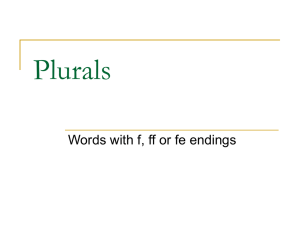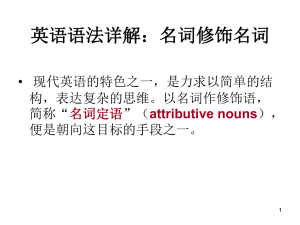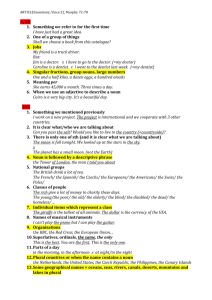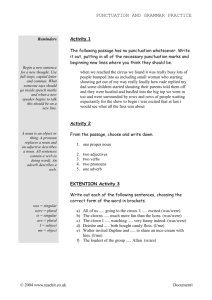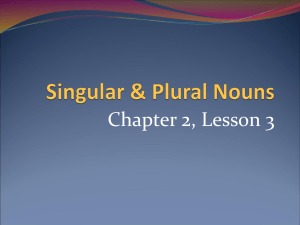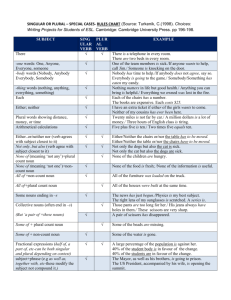Dortmund 1 - Constraints in Discourse
advertisement
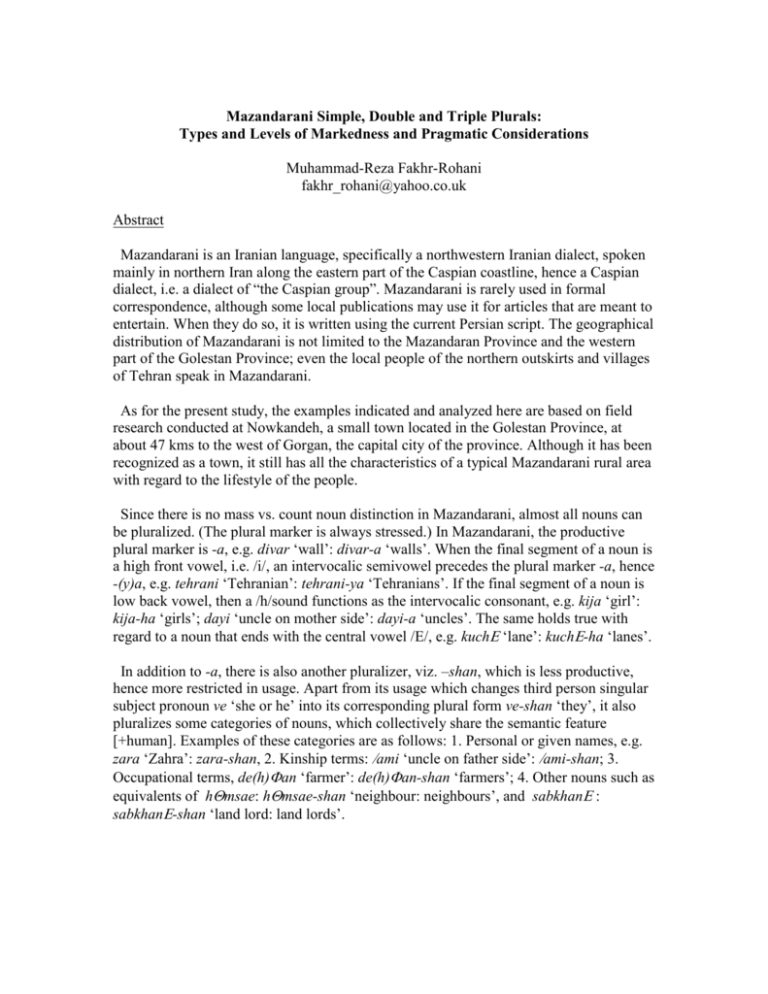
Mazandarani Simple, Double and Triple Plurals: Types and Levels of Markedness and Pragmatic Considerations Muhammad-Reza Fakhr-Rohani fakhr_rohani@yahoo.co.uk Abstract Mazandarani is an Iranian language, specifically a northwestern Iranian dialect, spoken mainly in northern Iran along the eastern part of the Caspian coastline, hence a Caspian dialect, i.e. a dialect of “the Caspian group”. Mazandarani is rarely used in formal correspondence, although some local publications may use it for articles that are meant to entertain. When they do so, it is written using the current Persian script. The geographical distribution of Mazandarani is not limited to the Mazandaran Province and the western part of the Golestan Province; even the local people of the northern outskirts and villages of Tehran speak in Mazandarani. As for the present study, the examples indicated and analyzed here are based on field research conducted at Nowkandeh, a small town located in the Golestan Province, at about 47 kms to the west of Gorgan, the capital city of the province. Although it has been recognized as a town, it still has all the characteristics of a typical Mazandarani rural area with regard to the lifestyle of the people. Since there is no mass vs. count noun distinction in Mazandarani, almost all nouns can be pluralized. (The plural marker is always stressed.) In Mazandarani, the productive plural marker is -a, e.g. divar ‘wall’: divar-a ‘walls’. When the final segment of a noun is a high front vowel, i.e. /i/, an intervocalic semivowel precedes the plural marker -a, hence -(y)a, e.g. tehrani ‘Tehranian’: tehrani-ya ‘Tehranians’. If the final segment of a noun is low back vowel, then a /h/sound functions as the intervocalic consonant, e.g. kija ‘girl’: kija-ha ‘girls’; dayi ‘uncle on mother side’: dayi-a ‘uncles’. The same holds true with regard to a noun that ends with the central vowel //, e.g. kuch ‘lane’: kuch-ha ‘lanes’. In addition to -a, there is also another pluralizer, viz. –shan, which is less productive, hence more restricted in usage. Apart from its usage which changes third person singular subject pronoun ve ‘she or he’ into its corresponding plural form ve-shan ‘they’, it also pluralizes some categories of nouns, which collectively share the semantic feature [+human]. Examples of these categories are as follows: 1. Personal or given names, e.g. zara ‘Zahra’: zara-shan, 2. Kinship terms: ami ‘uncle on father side’: ami-shan; 3. Occupational terms, de(h)an ‘farmer’: de(h)an-shan ‘farmers’; 4. Other nouns such as equivalents of hmsae: hmsae-shan ‘neighbour: neighbours’, and sabkhan : sabkhan-shan ‘land lord: land lords’. To sum up, Mazandarani has at least two plural markers, hence two distinct ways of pluralization.* A noun can be pluralized by adding -a as well as -shan; however, a noun, which is pluralized in these two different ways, conveys different meanings. For example, dayi ‘uncle on mother side’ can be pluralized as both dayi-a and dayi-shan. The former is just a plural form, but the second one conveys not one’s uncle individually, but it concerns, and includes, the uncle’s family or even his close friends as well. Granted that generally speaking the plural form is regarded marked and the singular unmarked (e.g. Corbett, 2001, p. 154; and Haspelmath, 2002, p. 238), out of the two plural markers already mentioned, -a has wider applications, hence an unmarked pluralizer and -shan has distributional restrictions, hence a marked plural marker. In terms of heaviness of marks (Waugh and Lafford, 1994, p. 2379), -shan is heavier by far than -a. There are also several instances of double pluralization. This process concerns both personal or given names and plural subject pronouns. A personal or given name can be double pluralized, e.g. m(h)di ‘Mahdi’: m(h)di-shan-a; mmmd ‘Muhammad’: mmmd-shan-a. The same may be done with kinship terms, e.g. me dayi-shan-a ‘my uncle-PL-Pl’, and te mar-shan-a ‘your mother-PL-PL’. Noteworthy is that when a kinship term is double pluralized, it is almost always preceded by a personal possessive adjective which signifies the one to whom the double pluralized referent belongs. It must be noted that the order of these plural markers cannot be reversed, because the resultant pluralized form may be meaningless or it might even sound insulting. However, if the name signifies a family name, or basically and traditionally a tribal name or designation, whether favourable or unfavourable, the order is reversed. Examples of this kind include jer-a-shan ‘the Ghajer tribe-PL-PL’, or jigi-a-shan ‘Jigi-PL-PL’. The latter forms of double plurals stress on those who belong to the tribe or family mentioned. Mazandarani plural subject pronouns are also doubled. This is done by adding -a to them: man ‘we’ changes to man-a ‘we-PL’; shman ‘you’ changes to shman-a ‘you-PL’; and veshan ‘they’ changes to veshan-a ‘they-PL’. These forms convey respect, emphasis, inclusion, or exclusion. In addition to double pluralization, there is also triple pluralization. Even a double pluralized noun may be pluralized once more, provided that none of the plural markers appear in juxtaposition with each other. In such an instance a noun first takes the unmarked, productive plural marker -a, then the marked, less productive plural marker shan, and then again the -a pluralizer. Examples of this sort include the following: me amm-(h)a-shan-a ‘my aunt-PL-PL-PL’. Pragmatically, these various instances of pluralization, whether simple, double, or triple, are indicative of the speaker’s attitude toward, and level of emphasis and/or particularization of, the referent and his or her family, relatives, or friends and the type of behaviour, tradition, or beliefs the speaker attributes to them collectively. * Nouns pluralized with -jat make up a quite limited number of words. They may show the influence of Persian in Mazandarani. There are still further noteworthy points in the phenomenon under study: Admitting that there is “a continuum of ‘markedness’” (Cook and Newson, 1996, p. 73), that “there are hierarchies of markedness” (Waugh and Lafford, 1994, p. 2380), and that “there is a scale from more to less marked.” (ibid.).On the basis of this, a hierarchy of marked forms is observable; in other words, there are levels of markedness. First, there is a dichotomy of singular vs. simple plural. Secondly, simple plurals can be dissected into less marked plurals that take -a, and more marked ones that take -shan. Thirdly, double plural markers are divided into two categories: 1. -a + -shan, and 2. -shan + -a. Finally, triple plurals only appears in the following ways: -a + -shan + -a; however, the rest of possible combinations which never appear are as follows: 1. *-a + -a + -shan, 2. *-shan + -a + -a, 3. *-shan + -a + -shan, 4. * -shan + -shan + -a, and *-a + -shan + -shan. A tentative analysis may be as follows: In Mazandarani triple plurals, no two identical plural markers can follow each other, and preference is for using as less heavy marks as possible. Bibliography Bhat,D. N. S. 2004. Pronouns: A Cross-Linguistic Study. Oxford: Oxford University Press. Cook, V., and M. Newson. 1996. Chomsky’s Universal Grammar: An Introduction, 2nd ed. Oxford: Blackwell. Corbett, G. G. 2000. Number. Cambridge: Cambridge University Press. Davis, S., ed. 1991. Pragmatics: A Reader. New York: Oxford University Press. Greenbaum, S. 2000. The Oxford Reference Grammar. Ed. E. Weiner. Oxford: Oxford University Press. Groves, P. 1998. Markedness. In Bouissac, P., ed., Encyclopedia of Semiotics, pp. 385387. New York: Oxford University Press. Haspelmath, M. 2002. Understanding Morphology. London: Arnold; New York: Oxford University Press. Levinson, S. C. 1983. Pragmatics. Cambridge: Cambridge University Press. Lyons, J. 1968. Introduction to Theoretical Linguistics. Cambridge: Cambridge University Press. Mey, J. L. 2001. Pragmatics: An Introduction, 2nd ed., Oxford: Blackwell. Rijkhoff, J. 2002. The Noun Phrase. Oxford: Oxford University Press. Shokri, G. 1995. Sari Dialect (Mazandarani). Tehran: Institute for Humanities and Cultural Studies. [In Persian] Waugh, L. R., and B. A. Lafford. 1994. Markedness. In Asher, R. E., and J. M. Y. Simpson, eds., The Encyclopedia of Language and Linguistics, 10 vols, vol. 5, pp. 23782383. Oxford: Pergamon.
